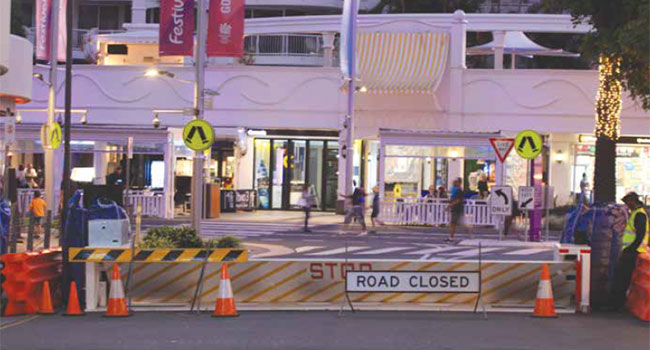
Shielding the Attendees
Vehicle tragedies emphasize need for pedestrian protection at large events
By their very nature, terrorist attacks and errant drivers,
who can also create untold damage, are unpredictable
and predicated on surprise. Staying one step
ahead by identifying vulnerable areas, and securing
them, is critical to staving off vehicular attacks. That
means being able to deploy security equipment in tough conditions,
at a moment’s notice.
Terrorists typically don’t go where they see barricades, so placing
them wherever possible attacks can happen reduces security risks
dramatically. Temporary barriers are often used to protect facilities
while permanent ones are being built. Plus, they’ve even been effective
for the long-term where physical conditions preclude permanent
solutions. Such are the cases at two very different events thousands
of miles apart, New Orleans’ annual Mardi Gras and the Commonwealth
Games held four years apart at varying British commonwealth
nations.
This has been happening for some time—vehicles being used as
weapons. Several years ago, on Dec. 19, 2016, the news exploded with
information about a vehicle attack on a Christmas market in Berlin
that killed at least 12 and injured more than 50. Less than a month
before, the U.S. State Department had warned about such attacks
in public places throughout Europe, saying that extremist groups including
the Islamic State and Al Qaeda were planning to focus on
such locales during the Holiday Season.
According to Aaron Miller, New Orleans’ director of homeland
security and preparedness, said three barriers were initially towed
into location just prior to the 2017 NBA All-Star game. Miller said
that in certain situations the portable barriers are more efficient than
current measures. Instead of police officers using patrol cars to close
streets, the barriers free officers to take care of other important police
matters. Miller also stated that the city intends to purchase more
portable barriers to block additional French Quarter intersections.
Unfortunately, in New Orleans, obtaining extra vehicle protection
quickly became a focal point since an intoxicated driver injured at
least 28 people when smashing into the Krewe of Endymion parade,
the largest at Mardi Gras, at one of the yet unprotected intersections.
Just as a terrorist can use a vehicle as a weapon to harm many people
quickly as in Berlin, the same results can be caused by an errant driver.
As a result, temporary vehicle barriers were later erected in New
Orleans’ French Quarter to restrict vehicle access to Bourbon Street
during Mardi Gras. The barriers, which were placed along cross
streets intersecting Bourbon, helped ensure no vehicles had access to
the heavily traveled walkways as Mardi Gras participants celebrated
in the Quarter. The barriers were raised at 5 p.m. from Feb. 22
through Mardi Gras‚ which ended on Feb. 28, and lowered at 5 a.m.
or earlier depending on crowds. New Orleans plans to continue use of
the portable barriers during special events in the future.
In the Land Down Under
In Australia, the Commonwealth Games, held in April 2018, on the Gold Coast, Queensland, Australia, included 4,400 athletes from
70 Commonwealth nations throughout the world, competing in 19
championship sports. It was the largest sporting event in Australia
since the 2000 Sydney Olympic Games. Organizers required a vehicle
access system that could be rapidly deployed and would create secure
vehicle check points that carried crash-certification.
“Barriers protected major event venues including the main games
stadium, Gold Coast Convention Centre, the Athletes Village and
critical street closures throughout the Gold Coast area,” said Matthew
Knight, director of Knight Brothers. “It was important for the
Games’ operations that access for emergency and authorized vehicles
was maintained through the duration of the event.”
Security focus had begun years prior to the games. The focus went
beyond hostile vehicle mitigation (HVM) measures to include various
other identified security risks. Perimeter security measures were
aligned with the recently implemented Australia and New Zealand
Counter Terrorism Committee (ANZCTC) strategy for the protection
of places of mass gatherings. A core element of this strategy
was the effective and practical implementation of HVM measures at
key locations. As the Australian partner of Delta Scientific, Knight
Brothers Pty Ltd secured the contract for the vehicle barrier systems
in late 2017 and liaised closely with organizers to ensure that specific
security measures could be achieved through implementing mobile
barrier systems.
In both New Orleans and the Australian Gold Coast, the totally
self-contained MP5000’s tow into position to control vehicle access
within 15 minutes. No excavation or sub-surface preparation is required.
Once positioned, the mobile barricades will unpack themselves
by using hydraulics to raise and lower the barriers off their
wheels. DC-powered pumps will then raise or lower the barriers.
These mobile deployable vehicle crash barriers carry a K8 rating
(M40 ASTM rating), stopping seven and a half ton vehicles traveling
40 mph.
“The primary use of the 20-foot portable barriers was in public
areas where ground fixation or in-situ HVM measures were not
practical or achievable,” Matthew said. “Barriers were deployed in a
variety of configurations in order to meet security and access needs.
This included direct access points as well as heightened temporary
security check points with stringent vehicle inspections undertaken
by Australian Defense Force staff. Secure access points at other locations
were operated by contracted security staff.”
At the Games, stand-alone battery-operated hydraulic systems
with supplementary solar power charging and remote-control operation
activated the barriers and allowed a high rate of vehicle throughput
in meeting specific operational requirements.
“Training of barrier deployment and operation was conducted
directly to Commonwealth Games security staff during barrier delivery
and commissioning. This ensured seamless integration of the
systems across the various deployment locations,”
said Daniel Knight, director of Knight Brothers.
“We were very proud to be a part of this prestigious
sporting event and to provide the first known
deployment of portable active vehicle barriers systems
on Australian soil.”
This article originally appeared in the July/August 2019 issue of Security Today.